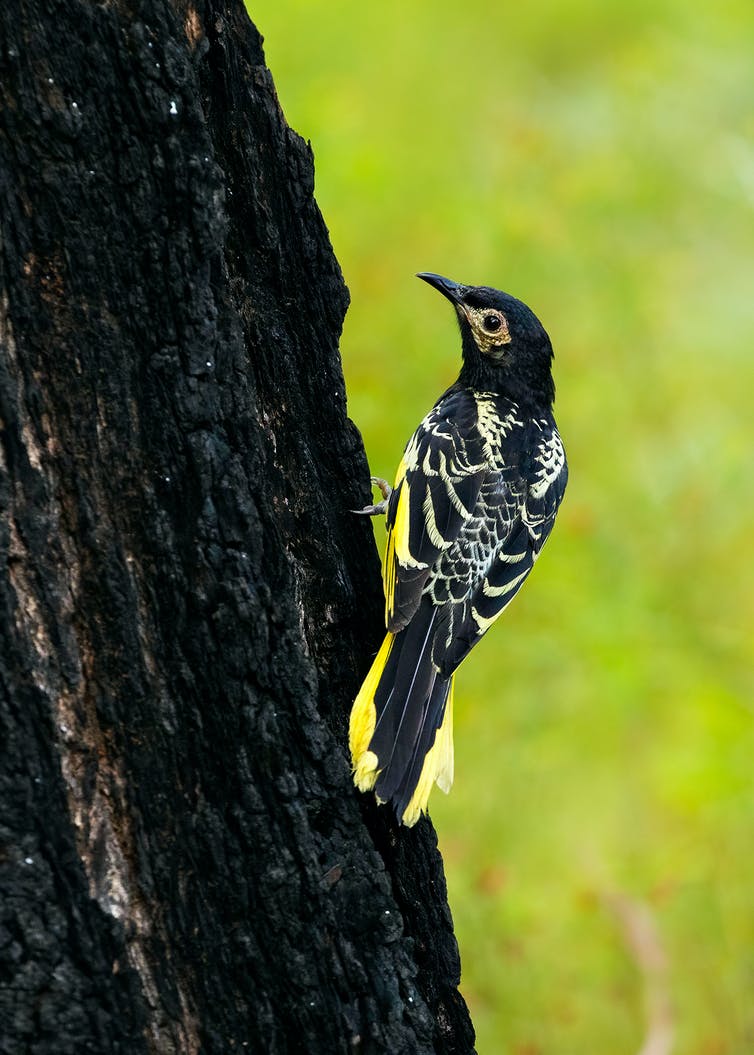Regent Honeyeater could be extinct 'within 20 years'
New research has warned that Regent Honeyeater will become extinct within 20 years unless conservation action to protect it is urgently boosted.
Eight decades ago, Regent Honeyeater was dominant in Australia's flowering gum forests, being easily observed in huge numbers. John Gould, one of Australia's earliest European naturalists, observed them "immense flocks among the brushes of New South Wales". He described Regent Honeyeater as "the most pugnacious bird he ever saw", noting they "reigned supreme in the largest, most heavily flowering trees". Their success in securing nectar supplies made them vital pollinators.
Since the time of Gould, Regent Honeyeater's population has collapsed in conjunction with the loss of more than 90% of their preferred woodland habitats to farmland.

Fewer than 300 Regent Honeyeaters remain in the wild in Australia, and numbers continue to decline (Lachlan Hall).
Though there are still large tracts of forest in Australia, these are often on poorer soils and hilltops. Remaining forests do not yield the rich nectar that Regent Honeyeaters require for breeding.
As their habitat has declined, the surviving Regent Honeyeaters have been forced to compete with larger species – without the safety of their huge flocks. The result is that the once-common species no longer reigns supreme.
The decline of Regent Honeyeater has been known since the late 1970s. In response, a recovery team including BirdLife Australia and Taronga Conservation Society launched a long-term recovery effort to protect habitat, plant new trees and release zoo-bred birds. These efforts have slowed but not arrested the decline, and it is now feared the remaining wild birds could be lost forever within two decades.
In 2015, a large-scale survey began to better understand the population decline. Regent Honeyeaters are notoriously difficult to study in the wild due to their nomadic behaviour. Six years of intensive fieldwork, coupled with data from research in the 1990s and long-term bird banding, means scientists have finally gathered enough information to be able to understand the challenges for the few remaining wild birds.
It is now known that breeding success has declined because their nests are raided and the chicks killed by aggressive native species, with Noisy Miners a particular problem. The remaining wild birds are losing their song culture because of a lack of older birds for fledglings to learn their songs.

The remaining Regent Honeyeaters are 'forgetting' their song, due to a lack of older birds in existence from which to learn it (Lachlan Hall).
Fieldwork has given accurate estimates of vital breeding data, such as how many young birds fledge for each adult female, how many birds are breeding and how well juveniles are surviving. The researchers combined this with data from the decades of monitoring of zoo-bred and released birds to create population models, which allowed them to predict the future for the wild population under different conservation scenarios.
The models show that time is critical. To have any chance of saving Regent Honeyeater, numbers must be built up enough for them to be able to roam in large flocks for protection.
To do this, conservationists have to nearly double the nesting success rate for both wild and released zoo-bred birds. Too many young birds are dying early; nesting Regent Honeyeaters need to be located early in the breeding season and protected from Noisy Miners, Pied Currawongs and even possums.
Despite decades of hard work, Regent Honeyeater is still inching towards extinction. The researchers conclude by saying that to recover the wild Regent Honeyeater population, the next five years will be critical for implementing the most effective conservation strategy.
They add that "we must think bigger" if the species is to be preserved, and large-scale habitat restoration is also a critical factor alongside captive breeding. Without this, releasing birds and protecting nests may ultimately prove futile.
References
Heinsohn, R, Lacy, R, Elphinstone, A & 8 others. 2022. Population viability in data deficient nomadic species: What it will take to save regent honeyeaters from extinction. Biological Conservation. DOI: https://doi.org/10.1016/j.biocon.2021.109430
This article draws on materials and information published by Rob Heinsohn, Dejan Stojanovic and Ross Crates in an article about their research on The Conversation.

